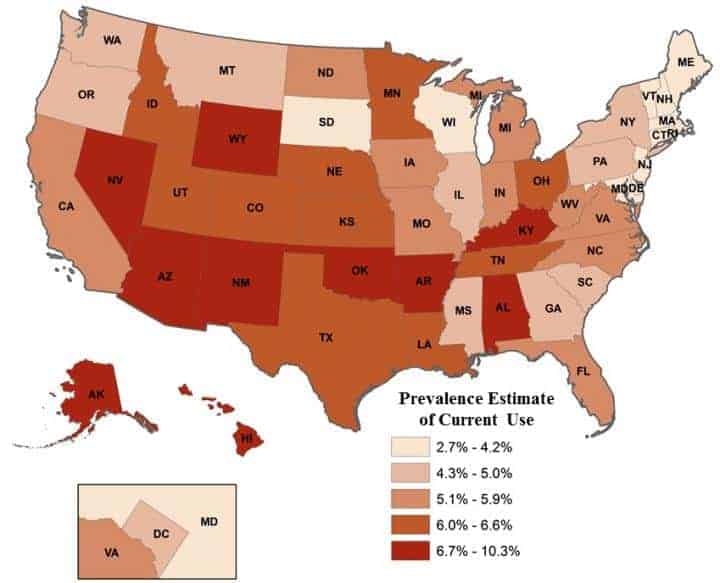States with robust tobacco control policies and regulations, such as smoke free air laws and taxes on cigarettes, not only have fewer cigarette users but also fewer e-cigarette users, according to research from NYU School of Medicine and the NYU College of Global Public Health.
The findings, published in the journal Nicotine & Tobacco Research, suggest that existing state-level tobacco control measures likely influence e-cigarette use, despite their focus on traditional cigarettes.
“Our research adds to the understanding of the geographic and sociodemographic factors underlying e-cigarette use within the existing tobacco control environment,” said Omar El-Shahawy, MD, MPH, PhD, a postdoctoral fellow in the Department of Population Health at NYU School of Medicine and the study’s lead author.
Tobacco control efforts worldwide have slowed the epidemic of tobacco use by introducing a variety of policies and regulations, including smoke free air laws, cigarette taxes, and increasing the availability of smoking cessation medications and counseling. In the United States, for example, the American Heart Association and its partners have worked effectively to bring 66 percent of the population under coverage of smoke free air laws.
In recent years, the use of e-cigarettes has rapidly grown. The current study examined the association between e-cigarette and cigarette use and existing state-level tobacco control measures. To calculate and map the use of e-cigarettes and cigarettes, the researchers used 2012-2013 and 2013-2014 data from the National Adult Tobacco Survey, a telephone survey of more than 60,000 U.S. adults. They looked at the prevalence of smoking and vaping over respondents’ lifetimes, as well as their current use, and accounted for a variety of sociodemographic factors.
The researchers used the American Lung Association’s State of Tobacco Control reports published in 2013 and 2014 to evaluate state tobacco control policies and measures, which they then compared with state-specific smoking and vaping rates.
More than 16 percent of adults in the United States have tried e-cigarettes in their lifetime; of these, one-third were current e-cigarette users, which translates to 5.4 percent overall current e-cigarette use prevalence. There is an assumption that e-cigarette use would help smokers switch away from combustible tobacco use; however, traditional cigarette use persists at more than three times the rate of current e-cigarette use, with more than 17 percent identifying as current smokers.
There were marked variations in e-cigarette use by region and state; mostly western and southern states tended to have higher rates, while rates in eastern states tended to be lower. Current e-cigarette use was highest in Oklahoma (10.3 percent) and lowest in Delaware (2.7 percent), and current cigarette use was highest in West Virginia (26.1 percent) and lowest in Utah (10.7 percent).
Of note, states with stronger implementation of tobacco control measures, including state-level funding for tobacco prevention and control programs that are recommended by the Centers of Disease Control and Prevention (CDC), had lower rates of both current cigarette and e-cigarette use.
The researchers point out that their study will be useful for monitoring the impact of future state and federal strategies and regulatory policies pertaining to e-cigarettes. E-cigarettes are believed to be less harmful than cigarettes since the combustion of conventional cigarettes releases most of the known elements linked to a variety of cancers; however, there is no long-term data about their safety. While e-cigarettes are marketed as aides for smoking cessation, “whether e-cigarettes actually help people quit tobacco use completely is currently under scrutiny among the tobacco control community,” said study author Scott E. Sherman, MD, MPH, professor of population health at NYU School of Medicine and an affiliated faculty member at the NYU College of Global Public Health.
“Several decades of research on traditional cigarettes guided the existing tobacco control environment. E-cigarettes are relatively new and constantly evolving, which makes the FDA’s task in regulating them very challenging,” said El-Shahawy. “There are still many unknowns pertaining to the role of e-cigarette in tobacco control. Until this ongoing debate is settled, tobacco control advocates and policy makers should continue focusing on enforcing the existing tobacco control interventions and regulatory framework.”
If our reporting has informed or inspired you, please consider making a donation. Every contribution, no matter the size, empowers us to continue delivering accurate, engaging, and trustworthy science and medical news. Independent journalism requires time, effort, and resources—your support ensures we can keep uncovering the stories that matter most to you.
Join us in making knowledge accessible and impactful. Thank you for standing with us!

